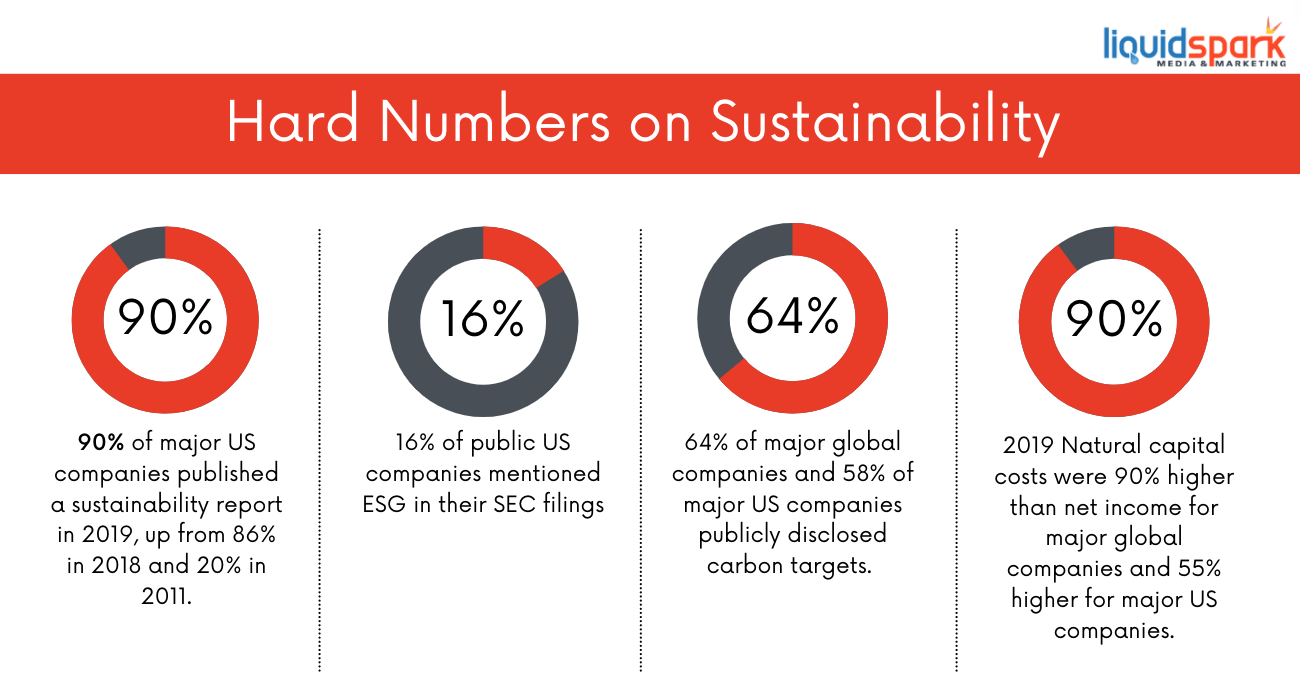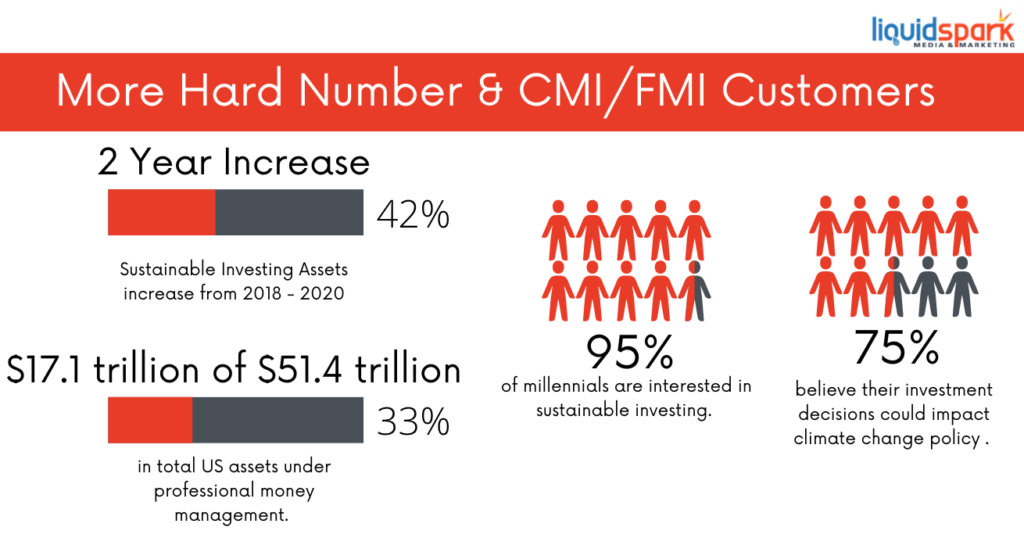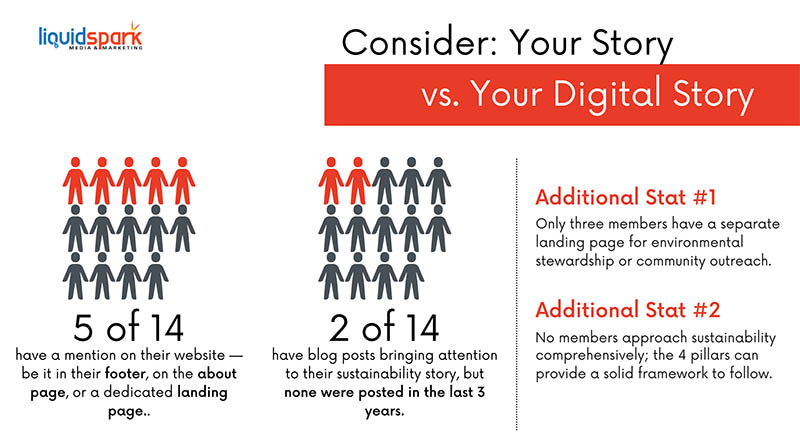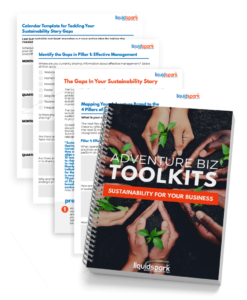Sustainability Insights Your Adventure Business Needs
In late October of 2021, I had the opportunity to give a presentation to a group of the top adventure outfitters in the USA, on any topic I wanted to talk about. I chose sustainability in business practices because it is both an urgent need, and not nearly as hard to start as some businesses think. Adventure outfitter companies actually have a mixed record on sustainability, for a wide variety of reasons. Some of those are based in practical business reasons, and some are based on incomplete information. Conversely, many outfitters are doing more than they actually share publicly. Researching current sustainability trends for this presentation revealed surprising, and welcome, data about mainstream businesses jumping in at an unprecedented level. Sustainability is no longer a topic relegated to companies with deep pockets or purely eco-evangelist companies.
The 2020-2021 covid pandemic thrust sustainability to the very front of business conversations and behavior. Sustainability of ecosystems, communities, and economies impacts the largest cities and countries and the tiniest towns and villages. During 2020-2021 – the lack of sustainability became visible and real.
2021 also saw really encouraging trends about the growth of sustainability as a critical business practice, in mainstream global businesses, and in the travel and tourism industry. Sustainability has gone mainstream and is now a key metric being reported on along with financial data. The travel and tourism industry has stepped up its game from Sustainability 1.0 to Regenerative Tourism 2.0.
These trends offer a keen view into how even the most reluctant large businesses are changing, what leaders in tourism are doing, what customers are demanding, and what we will see more of in 2022 and beyond. In fact, GreenBiz just published their 2022 sustainability trends and it’s a continuation of the 2021 trends with more urgency and bigger impacts. Check out their 2o22 State of Green Business Report.
If you are on the sidelines of sustainability still, jump in and read this post.
What we’ll cover:
- Definitions: Sustainability, Sustainable Tourism, Regenerative Tourism
- Sustainability Has Become Part of Mainstream Business Fundamentals
- How the Travel & Tourism Industry Measures Sustainability
- Data on Global Sustainability Reporting, Investing, & Demographics
- Top 10 2021 Global Sustainable Business Trends
- Telling Your Sustainability Story
- Sustainability Certifications
- Next Steps
Definitions: Sustainability, Sustainable Tourism, & Regenerative Tourism
Sustainability:
- the ability to be maintained at a certain rate or level.
“the sustainability of economic growth” - avoidance of the depletion of natural resources in order to maintain an ecological balance.
“the pursuit of global environmental sustainability”
Source: Oxford dictionary - Sustainability focuses on meeting the needs of the present without compromising the ability of future generations to meet their needs.
Source: 1987 Brundtland Commission report for the United Nations
Sustainability means to be able to keep going indefinitely with your current business practices, without depletion of resources, climate disaster, pollution, social unrest or any number of problems occurring that prevent this business as usual approach. Sustainability requires a long lens of time, i.e. more than a single lifetime.
Sustainable Tourism: Do no (additional) harm
The concept of sustainable tourism is decades old and is comprehensive beyond a single business or single lifetime/generation lens. The United Nations World Tourism Organization (UNWTO) defines it as:
“Sustainable tourism is tourism that takes full account of its current and future economic, social and environmental impacts, addressing the needs of visitors, the industry, the environment and host communities.”
– UNWTO
There is no such thing as “single topic” sustainable tourism. Note how the UNWTO definition addresses an integrated cohesive understanding of everything tourism impacts. As important, sustainable tourism applies to all forms of tourism, not just to certain categories of tourism, like adventure travel. All tourism can make a difference.
“Sustainable tourism development guidelines and management practices are applicable to all forms of tourism in all types of destinations, including mass tourism and niche tourism segments.”
– UNWTO
Furthermore, sustainable tourism has a goal of supporting a place and its people in a positive way, and at a minimum, doesn’t cause any additional damage to them.
Regenerative Tourism: Do good
This is an easy to understand concept, AND it is a total upgrade to the concept of sustainability. As humans have become more aware of what our world needs to survive and thrive, the focus has shifted to “Sustainability 2.0” – a proactive approach called regenerative tourism.
Regenerative means able to or tending to regenerate—to regrow or be renewed or restored, especially after being damaged or lost.
Regenerative Tourism tries to leave a place and its people better than they were before. Although considered a bit of a buzzword in 2020 and 2021, regenerative tourism has become the priority for fully engaged tourism destinations, organizations, and companies who recognize the interdependence between culture, economy, society, and environment. These companies, across all industries, focus on aligning and revising their business practices to create positive outcomes in the environment, communities, and economies in which they operate.
Sustainability Has Become Part of Mainstream Business Fundamentals
The Covid pandemic highlighted the devastation of current business as usual, and has accelerated the importance of sustainability and of taking measurable actions now. The 2021 State of Green Business Report made clear the need to embrace sustainability for future economic success, and even for survival. The Green Business Report is produced in collaboration with S&P Global and covers the largest 500 companies in the US and the largest 1200 companies globally.
“According to the OECD, for the economic recovery from the crisis to be durable and resilient, a return to business as usual and environmentally destructive investment patterns and activities must be avoided. Unchecked, global environmental emergencies, such as climate change and biodiversity loss, could cause social and economic damages far larger than those caused by the virus.”
–State of Green Business 2021, page 8
“Sustainability is now seen as key to minimizing risk, increasing resilience, enhancing competitiveness, and unlocking new opportunities”.
Mainstream, large global and USA companies are responding. In fact, in 2021, an exceptional number of these top companies are voluntarily reporting a second set of metrics in their annual SEC reports, based exclusively around sustainability metrics. This is in addition to their standard financial reporting metrics.
Sustainability Reporting: ESG – Environmental, Social and Governance (ESG) Metrics Have Arrived
This sea change in acknowledging and voluntarily reporting on sustainability metrics has speeded up in recent years. It’s gone from only 20% of the USA’s largest companies reporting on sustainability in 2011 to over 96% reporting ESG metrics in 2020. And, over half the companies also acknowledge the financial risks of climate change in their reporting, with a majority establishing targets to reduce carbon emissions. Companies (the people who run them) are inherently self-interested, of course. Their motivation to report on these new ESG metrics is because the public and various industries are using these metrics to help determine the full value of companies. It’s good business, and good for (their) business. The benefits of ESG programs that lead to strong ESG results include:
- Risk management
- Reputation management
- Human resource efficiency
- Employee commitment, productivity, and retention
- Improved stakeholder trust
- Pre-empting of upcoming regulations
- Community approval
- Customer commitment, referrals, and retention
Let’s take a look at what these ESG Metrics are, and how strikingly similar they are to the well-known sustainability metrics of the global tourism industry. Except for G – Governance, where we see that this particular metric is designed primarily to keep bad behavior in check. The tourism industry looks at effective management – more on that in a bit.
What are these (mainstream) ESG Business Fundamentals?
E – ENVIRONMENTAL
Conservation of the Natural World
S – SOCIAL
Consideration of People & Relationships
G – Governance
Standards for Running a Company
E – Environmental
- Climate change & carbon emissions
- Air & water pollution
- Biodiversity
- Deforestation
- Energy efficiency
- Waste management
- Water scarcity
S – Social
- Customer satisfaction
- Data protection and privacy
- Gender and diversity
- Employee engagement
- Community relations
- Human rights
- Labor standards
G – Governance
- Board composition
- Audit committee structure
- Bribery and corruption
- Executive compensation
- Lobbying
- Political contributions
- Whistleblower schemes
How the Travel & Tourism Industry Measures Sustainability
The travel and tourism industry, and more specifically the adventure tourism niche within travel and tourism, has its own version of ESG non-financial factors to report on.
The Global Sustainable Tourism Council created the global baseline of standards of sustainable travel and tourism to help guide us with effective and measurable ways to create positive impacts through our tourism businesses, organizations, and destinations. It’s an inclusive framework for sustainability that we go into detail about in this post—but we’ll just summarize it here:
The Four Pillars of Sustainable Tourism
- Pillar #1 – Effective Management: How are you implementing and managing sustainable practices across your tourism business? Without effective management of your sustainability initiatives, your efforts may miss the mark. (And, if you aren’t measuring your efforts, you might not even know it!)
- Pillar #2 – Social & Economic: How are you helping the places where your tourism product operates? Maximizing social and economic benefits to the local community and minimizing negative impacts are the essence of pillar #2. How are you supporting diversity within your organization, your customer and vendor relationships, and the communities in which you operate?
- Pillar # 3 – Cultural: How does your tourism business support cultural heritage? Are you focused on maximizing benefits to cultural heritage and minimizing your negative impacts?
- Pillar #4 – Environment: How are you protecting, conserving, educating, and being a net positive steward of the environment and ecosystem in which you operate? Are you mitigating damage, applying restorative solutions, or both? Getting community and tourists to both participate and lead – is key. With your tourism products – how you can get your customers/ partners/ community excited about and involved in, your sustainability projects?
This framework is a helpful way for tourism businesses to organize their sustainability efforts to be sure they are comprehensive, on target, and able to be measured.
These four pillars are indeed similar to the Financial plus ESG metrics of large, public, global and USA corporations. I am calling them mainstream companies, as a differentiator from the adventure tourism niche industry, but really these are companies whose corporate valuations can rise and fall based on both required and voluntary reporting.
Note how the very first pillar is Effective Management, and how Social and Economic are combined (as two sides of one coin), how Cultural is a called out in its category, and environmental rounds out the final pillar. Without effective management and measurement of your sustainability plan, achieving success in Pillars 2, 3, and 4 are less likely. I do chuckle, albeit in a cynical way to be sure, that the Governance metric for corporations has much more to do with mitigating bad behavior in the boardroom or leadership suites, rather than effective management with positive metrics.
Data on Sustainability Reporting, Investing, & Demographics
The current data around sustainability reporting and investing is a clear indicator of the shift in business and markets to valuing sustainability practices. While US businesses lag European in ESG reporting, the majority are publishing sustainability reports. Adventure tourism companies who have modeled the often times lonely way to greater sustainability, are no longer outliers, indeed.
Think about who your company’s customers and prospects are? Do they share similar characteristics?

- 90% of major US companies published a sustainability report in 2019, up from 86% in 2018 and 20% in 2011.
- 16% of public US companies mentioned ESG in their SEC filings
- 64% of major global companies and 58% of major US companies publicly disclosed carbon targets.
- 2019 Natural capital costs (putting monetary valuations on environmental impacts to natural resources) were 90% higher than net income for major global companies and 55% higher for major US companies.
Source: State of Green Business 2021, page 90
When I talked with these leading adventure outfitters this fall, we quickly went from what global large corporations are doing in their sustainability practices to looking at what customers and prospects are doing and thinking about sustainability. We have all heard for years that travelers value companies who are doing the “right thing” with sustainable business practices. We’ve seen interest surveys and intent to buy surveys around tourism products. This data below offers tangible evidence of customers putting their money where their beliefs are in a significant way – through their investments. Fully one third of all investments in 2020 were in sustainable investing – over $17.1 trillion.
Let’s look at what this might mean for your business. Think about who your company’s customers and prospects are. These are your Current Most Important (CMI) customers and your Future Most Important (FMI) customers. Are they in the broad millennial generation now? Or will they be in a few short years, if your customers are older now?
Would your company be smart to position itself as a sustainable company, in addition to being a high quality provider of adventure experiences?

The numbers continue to tell a story when considering CMI > Current Most Important ; FMI > Future Most Important customers.
- Sustainable Investing Assets increased 42% from 2018 to 2020 – 33% ($17.1 trillion) of the $51.4 trillion in total US assets under professional money management.
- 95% of millennials are interested in sustainable investing, and 75% believe their investment decisions could impact climate change policy .
Source: Morgan Stanley Institute for Sustainable Investing
REMINDER
The millennial generation is 1980-1995, ages 26-41. Are these your customers now, or will they be in several years? And if this demographic is this focused on sustainable investing, do you think that sustainability in their vacation experience choices could also be an important conversion factor for them? What can you do now, to develop or grow your sustainable or regenerative tourism practices to win their business? Good for your business, good for your customers, good for the world.
Top 10 Global Sustainability Business Trends
It’s fascinating and inspiring to look at the top 10 global sustainability business trends from 2021. As tourism providers, how do these trends relate to your business, and your customers? Certainly natural assets (think rivers, trails, remote places, forests, etc.) are a key driver of your business. Think beyond your individual businesses – are there regenerative tourism community or regional partnerships that can be a win for all involved?
1. Ocean-based Sequestration Heats Up
Nature-based solutions to carbon sequestration including forest offsets, soil carbon, and now blue carbon. Players include Conservation International, Running Tide, Ocean-based Climate Solutions, Planetary Hydrogen, Shopify Funding.
2. The “S” in ESG Gains Currency
Impact on society/social responsibility as it relates to workforce, gender, diversity, community, geopolitical matters. Players include European Commission, EDGE Certified Foundation, UN, World Economic Forum.
3. Community Investments Pay Dividends
Companies have figured out that direct investments by businesses benefits operations and the communities in which they serve. Education, purchasing and sourcing strategies, non-profit partnerships. Players include 1% for the Planet, Sustainable Purchasing Leadership Council, Rainforest Alliance.
4. Aquaculture becomes a Net-Positive
Currently is 52% of global fish consumption, will be 60% by 2030. Fish, shellfish, and seaweed all being farmed. Players include Publix, Cargill, GreenWave.
5. Industrial Decarbonization Picks Up Steam
Industries are moving to carbon neutral operations; internal factories and external supply chains. Players include Apple, Mars Inc.)
6. Nature Takes Root on the Balance Sheet
World Economic Forum creates framework to understand, report on and translate nature-related risks into financial terms to help redirect the flows of finance towards nature-positive activities. Players include Puma, Business For Nature.
7. Sustainable Mobility Drives the Newest Perk
Big companies offer sustainable choices for commuting and transportation like car-pooling, EVs, EV chargers on campus electric buses, financial incentives for buying bikes, e-bikes…etc. Players include Clif Bar, Genentech, Ingka Group.
8. Aviation Plots a Sustainable Course
SAF – sustainable aviation fuel, carbon offsets, airplane electrification, Hydrogen technologies. Players include Rolls Royce, JetBlue, Shell Aviation.
9. The Circular Economy Shows its Human Side
Focus on both upstream (virgin materials supply chain) and downstream (recycling, repairing, refurbishing and redeploying materials). Players include HP Inc., Work.
10. Corporate Advocacy Gets Louder
Pro-climate policy changes won’t take hold without a bold push from companies. The business world is recognizing that the most powerful tool they have to combat climate change is their Political Influence. More companies are understanding that their interests are directly linked to a clean environment, healthy citizens, and a cohesive society. Players include VF Corp., The North Face, Timberland, Patagonia.
Are You Telling Your Sustainability Story?
Most adventure brands are doing “something” within the 4 Pillars of Sustainable Tourism. It’s really quite rare to find anyone with zero for any sustainability practices. In fact, the biggest “miss” we see is that many adventure brands don’t actually integrate their sustainability story into their overall marketing efforts. Some are afraid of “greenwashing” – if their actual programs don’t measure up to the full hype – which is of course a different story altogether. That means it’s time to examine, measure, and upgrade your program (Pillar 1).
For this presentation, I took a look at 14 leading outdoor adventure brands. There was a big gap between what they are actually doing, versus what they are sharing on their digital channels. How about your company?

- 5 of 14 have a mention of their sustainability story on their website—be it in their footer, on the about about page, or a dedicated landing page.
- 2 of 14 have blog posts bringing attention to their sustainability story, but none were posted in the last 3 years.
- Only 3 of 14 have a separate landing page for environmental stewardship or community outreach work.
- 0 of 14 approach sustainability comprehensively; there’s an incredible opportunity for all to use the 4 pillars of sustainability as a framework to follow.
Highlighting your sustainability story helps attract an audience and customers who are emotionally invested in your brand, which increase their brand loyalty and retention. These are your future evangelist fans, right?
Consider this research insight document done by IBM and the Nation Retail Federation in their June 2020 report—which is still relevant as we head into 2022:
“Sustainability has reached a tipping point. As consumers increasingly embrace social causes, they seek products and brands that align with their values. Nearly 6 in 10 consumers surveyed are willing to change their shopping habits to reduce environmental impact. Nearly eight in 10 respondents indicate sustainability is important for them. And for those who say it is very/extremely important, over 70 percent would pay a premium of 35 percent, on average, for brands that are sustainable and environmentally responsible.”
How this applies to the travel and tourism industry:
If your adventure brand can align with your customer’s values when it comes to being socially and environmentally responsible, it becomes an easy decision for them.
When it comes to your Sustainability Story, you’re considering two key questions:
- What can you do in your individual adventure brand, and collective adventure industry – to move boldly into regenerative tourism practices?
- How will you effectively and authentically share your story in your marketing to help customers choose you?
Download our free Adventure Business Toolkit: Sustainability for Your Business

While the concept of sustainability and sustainable tourism is decades old, it is now an essential piece of smart business fundamentals.
Our all new Sustainability For Your Business Toolkit is a powerful and easy to use, proven framework to identify and assess the many ways you can implement and communicate on measurable, high impact sustainability practices for your company to support your triple bottom line.
Obtaining a Certification in Sustainable Tourism
The challenge with Sustainable Tourism certification is that it is time-consuming and can be expensive. The decision of whether or not to certify is specific to each company, organization, or destination.
There are increasingly strong competitive reasons and incentives (both financial and non-financial) to push ahead and get a third-party certification, which we’ve touched on in this post. The most important thing, however, is to DO the sustainability work to benefit the people, communities, and environment in which you operate.
How does the certification process work?
The Global Sustainable Tourism Council itself does not certify operators or organizations. It provides the globally accepted criteria by which your organization will be measured in order to receive certification. There are a number of accredited organizations that certify. These organizations can also help you with understanding where you are now and where you need to be, in order to be successfully certified. Here are examples. Find an extensive list at GSTC.
GSTC-Accredited Certification Bodies
- EarthCheck
- Green Destinations
- Vireo Srl
- Control Union
- Bureau Veritas
- United Certification Systems Unlimited
Explore the certification criteria for:
Tour Operators
Hotels & Accommodations
Destinations
Next Steps for Sustainable & Regenerative Tourism You Can Take Immediately
Visit the Global Sustainable Tourism Council to learn more about criteria for sustainable tourism, specifically for your brand. Learn what kinds of certifications are available, what does certification offers you, and which organizations do GSTC criteria certifications around the globe.
Then consider taking an inventory of your current sustainability practices. What’s working, what’s not? How are you measuring your impact? Develop an effective management plan by using the Liquid Spark Sustainable Tourism Toolkit.
One Percent for the Planet
This is an easy, big, and immensely rewarding step to take to add meaningful sustainability practices to your company, immediately. Investigate the 1% for the Planet non-profit organization. Liquid Spark is proud to be a member, since 2014. Several of our amazing clients are also members, and we’d love to share with you why we joined, how it works, and what the impacts are.
Parting Note
Does the idea of developing or expanding your sustainability practices at your adventure brand overwhelm you, seem incredibly daunting, or cause intense panic around your financial stability? It doesn’t have to be that hard! Reach out for support in your sustainability plan.
Want More Tips & Resources?
90% of major US companies

